As Theodore Roosevelt once said, “Nothing in the world is worth having or worth doing unless it means effort, pain, difficulty.” Experience has taught us that making a dream come true, more often than not, involves vision, persistence, and sacrifice. And, in the case of overland travel, making a dream come true involves a fair amount of good old-fashioned elbow grease, especially if you tour with an old Land Rover.
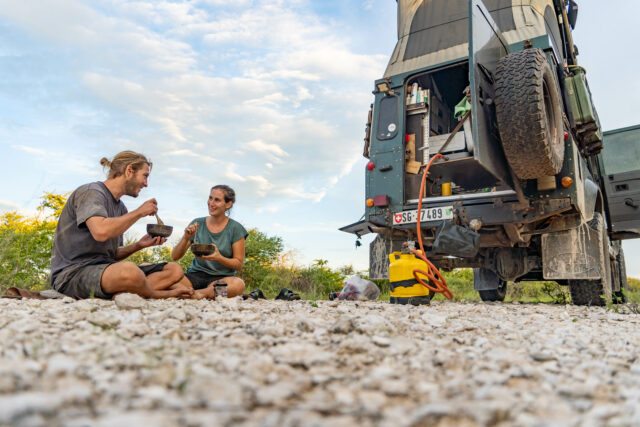
In this interview, we delve into the story of Toby and Martina, Swiss adventurers who have embarked on a remarkable overland vehicle build and subsequent expedition, which has had its fair share of drama. Their vehicle, a 1997 Land Rover Defender 110 dubbed Olga, is their home on wheels as they traverse diverse landscapes and cultures globally. As with all good overland journeys, theirs is marked by a spirit of self-reliance, challenges, and triumphs (they had to rebuild the vehicle twice, the second time due to an off-road accident).


Toby is a 33-year-old skilled metalworker and a former project manager, and Martina is 29 years old with a background in psychology. These unique skills have undoubtedly shaped their approach to the overland adventure they’ve undertaken. We all know how important being handy and mentally well-adjusted can be on the long road.
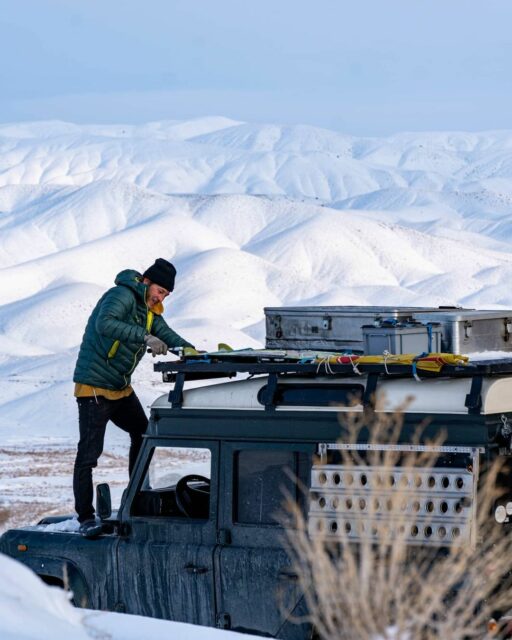
The origin of their overland journey dates back to a chance encounter in the Canadian wilderness. While backpacking around the globe, Toby crossed paths with and spent a week with a group of young travelers who were exploring the world in their rebuilt Defender. This encounter ignited a spark in Toby, inspiring him to embark on a similar adventure, and a decade later, Toby and Martina began their overland journey.



Choosing the Defender as their base vehicle wasn’t merely coincidental. A blend of nostalgia and practicality influenced this decision. The love affair with the Defender began in Canada and continued to blossom over the years. This enduring affection was inspired not only by the Defender’s rugged good looks but also by the vehicle’s robustness, its simple 4×4 mechanics, and the welcoming community that rallies around this iconic automobile and the brave souls who travel with them.

The couple bought the 1997 Land Rover Defender 110, with 130,000 miles on the odometer, in Switzerland back in 2017 for the grand sum of $17,000. A labor of love awaited them as they meticulously rebuilt the vehicle to meet their unique needs and preferences. The extensive modification took three years, and throughout this period, Toby and Martina balanced their overland build project with full-time work and academic commitments.

The first task was to strip the Defender’s interior, including all seats and floorboards, to expose the rusty chassis. Armed with a sandblaster, grinder, sandpaper, and wire brushes, the couple attacked the rust and eventually were rewarded with a solid, cancer-free frame. All sheet metal was replaced, and the frame and sheets were treated with rust and corrosion-inhibitive layers of specifically purposed paint, oil, and wax. The interior was then extensively insulated before the construction of the home on wheels began in earnest. The interior layout was designed to offer ample storage capacity while ensuring sufficient living space for the two budding explorers. A key enhancement was a pop-up roof, expertly installed by AbenteuerTechniks in Cologne. This $6,000 wedge-style roof tent enables both standing room within the vehicle and the option to sleep in a well-ventilated area.



After installing the pop-up roof, the couple dusted off their woodworking tools to construct the interior furniture and storage compartments. When selecting the wood, they sought durable panels with a high load-bearing capacity and water-repellent properties. They chose 16-millimeter, screen-printed boards, which come pre-coated, a distinguishing feature from regular multiplex boards. A seating area was skillfully crafted in the rear of the vehicle, designed for conversion into an additional bed when needed. The wood structure was affixed directly onto the wheel wells and the insulation layer. Some storage space was sacrificed, but the available living area was greatly improved overall.


Storage compartments were integrated beneath each rear seat. The space within the rear footwell accommodates up to 50 liters of water and various oversized items. Adjacent to the wheel wells, purpose-built compartments were constructed, providing ample room for a variety of utensils. A large, attractive cupboard was securely attached atop the wooden framework, complete with a pull-out table, accompanied by a 35-liter compressor Engel fridge. Beneath the refrigerator, an additional storage compartment and a side-accessible drawer was installed. The interior was finished by applying leather to the headliner, creating curtains for all windows, and mounting a foldable table on the rear door. The culmination of this undertaking was the comprehensive attention given to the electrical system, which was kept intentionally basic and functional.

Toby and Martina’s approach to interior design was a blend of research and intuition. They drew inspiration from various sources, including YouTube videos and other fellow overlanders’ setups. However, the ultimate design was a result of their creativity and resourcefulness. The interior and exterior modifications were executed meticulously if they do say so themselves (their journey of transformation can be explored in detail on their website).

Their maiden “shakedown” voyage took them to Norway, where they tested their setup and relished the thrill of adventure. However, as expected, the road ahead was not without its share of challenges. As they ventured into more demanding terrains, mechanical issues began to emerge due to their vehicle’s unpreparedness for heavy-duty tasks. Such experiences taught them invaluable lessons about the importance of robust mechanical modifications before embarking on rugged journeys, and the repairs were duly carried out before hitting the road to Turkey.

Breakdowns and setbacks, while frustrating, became sources of growth. Three months into their extensive journey, a significant rollover accident occurred during their exploration of Cappadocia, Turkey, where they took a detour onto a road that proved to be more challenging than anticipated. Initially unaware of the difficulties that lay ahead, they encountered a progressively narrow pathway that led them into a canyon. After evaluating their circumstances and a thorough walk through the canyon, they concluded that reversing was not feasible. Instead, they committed to navigating down to the valley. Persisting along this route, the right front wheel lost traction, triggering Olga’s uncontrolled descent down the slope and resulting in a complete rollover that ended with the vehicle resting on her head within a bush on the slope, luckily no one was injured! After a five-hour recovery, aided by two other Defenders and a tractor, they successfully reclaimed their vehicle. Olga’s condition was, however, quite dire—shattered windows, a torn roof rack with its cargo strewn, a heavily dented right fender, and substantial damage to the remaining body of the car.
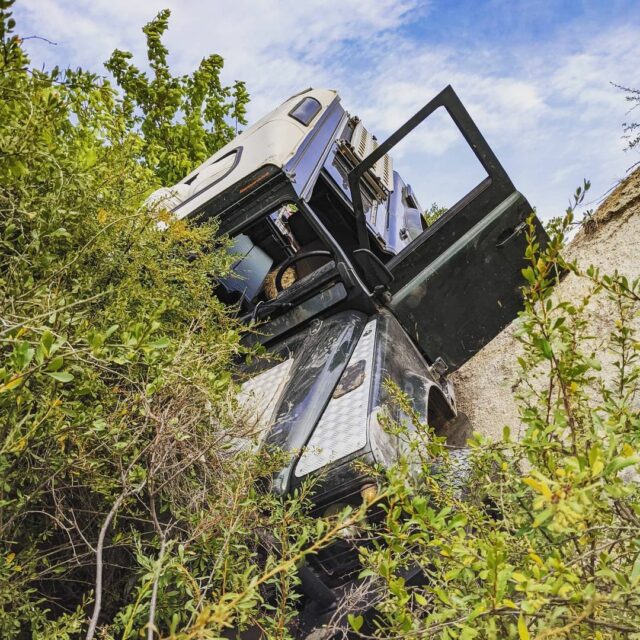





Luckily, the engine remained unscathed, with much of the interior surviving the ordeal, but the body was so severely damaged that Olga needed replacement of every exterior component apart from the rear door and the hood. Olga underwent a complete makeover. Once the arrangements with their insurance provider were sorted, they disassembled the Landy piece by piece


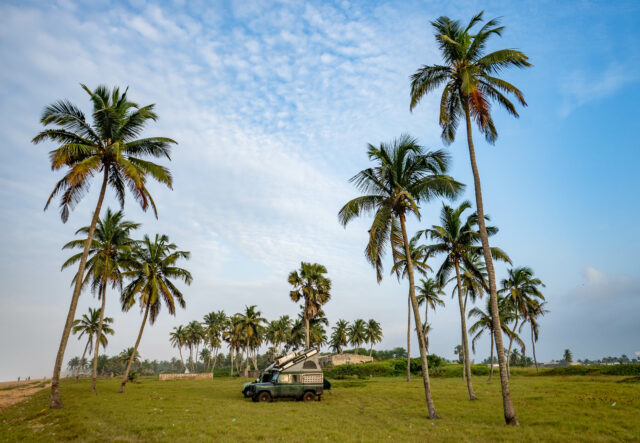
While reassembly was the primary focus of the repair process, a multitude of smaller tasks consumed a significant amount of time. These included restoring the lifting roof, the snorkel, and the roof rack, rewiring the electrical system, dismantling and reinstalling the entire interior, removing the bumper, sand plates, and canisters, and affixing new headlights. Naturally, they encountered challenges as specific body parts failed to align perfectly, and certain spare parts deliveries were flawed. Due to various setbacks, including delivery delays and complications with the Turkish insurance evaluator, what was to be a three-week project was extended into a three-month endeavor.



Eventually, back on the road, the couple continued their journey with a commitment to wild camping, enjoying a sense of independence and a connection to nature. Throughout their total 860 days of travel, they spent a mere 50 nights in organized accommodations, a testament to their love for remote and serene locations and a great way to save money after an expensive rebuild.

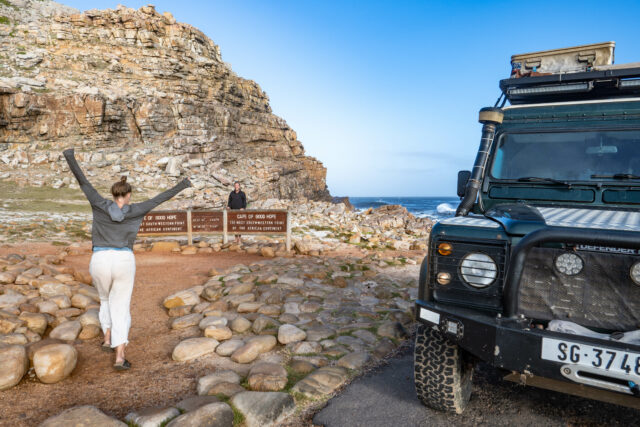

Toby and Martina’s overland journey has taken them across continents and through diverse cultures. From traversing the Lut Desert in Iran to embarking on a 1,000-kilometer off-road crossing of the Rub’ al-Khali, they’ve sought challenges that push their boundaries and remarkably fulfilled their desire for desert travel. Their travels have been diverse, ranging from sections of the Silk Road to the Arabian Peninsula and even a loop around Africa.

Once Toby and Martina reached South Africa, they were devastated to find a crack in their chassis and decided to galvanize the chassis, which meant a complete rebuild from scratch. Every nut and bolt was replaced, and they managed to complete the dire task within one month, with Toby and Martina working 16 to 20 hours a day to complete the transformation. They were unfortunately rushed as Martina had planned to return home to Switzerland as she was six months pregnant with their son Lio.

Looking ahead, Toby and Martina dream of a future where their overland adventures include their children; Martina became pregnant while the couple were on the road in Africa. The remainder of the Silk Road and the Pan-American Highway beckon, promising new adventures for the family unit.

Reflecting on their experiences, Toby and Martina stress the importance of using quality products and the value of hands-on experience, dealing with your own drama, and learning as you go. The lessons learned along the way have reinforced their commitment to practicality and the joys of a simpler, more self-reliant life.
Specifications
Land Rover Defender 110, 300 TDI, 1997
Power
2,495cc (2.5 litres) 4-cylinder turbo-diesel
Suspension and Drive
Upgraded TJM springs and shocks

Wheels and Tires
- Steel Wheels
- BFGoodrich AT 265/75R16
Recovery Gear
- Winch
- Sand ladders
- Recovery straps

Accessories
- Self-made front bumper
- Snorkel (higher air intake)
- Two 25-liter water canisters
Electrical System
- Two 140-watt solar panels
- Double battery system with AGM starter battery and 100 amp hour lithium battery+
- Victron smart shunt
- 300 watt inverter
Interior
- Riva-filter water system
- Gas bottle
- Two-burner stove
- Jetboil
- Optimus Polaris multi-fuel stove
- MSR stove
- Engel 12-volt 35-liter fridge

To learn more about their journey, visit their website at olgaontour.ch and follow their adventures on Instagram @olgaontour
https://www.youtube.com/watch?v=3poOd-Mfz1w
Read More: Will the New Toyota Land Cruiser Be the Vehicle We Want It to Be?
More Land Rover Builds:
2003 Land Rover Defender 130 / Four Wheel Campers Fleet model shell
2004 Land Rover Defender 110 Pickup “The Monster”
2000 Land Rover Defender 110 by Projeto Mundo Cão
Our No Compromise Clause: We do not accept advertorial content or allow advertising to influence our coverage, and our contributors are guaranteed editorial independence. Overland International may earn a small commission from affiliate links included in this article. We appreciate your support.


